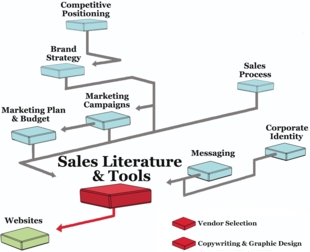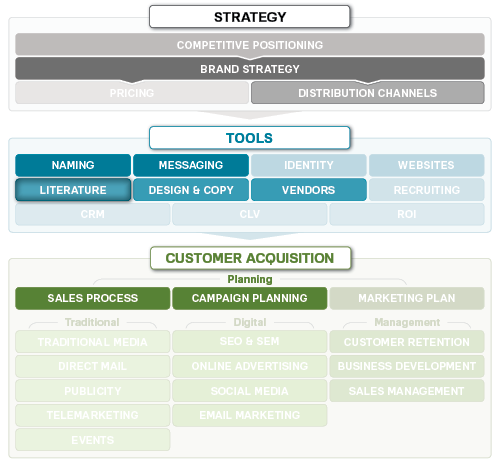Marketing Guides
Creative & Brand Development
Sales Literature and Tools
Do you know many companies that can sell their product or service without literature or other supporting materials? It’s tough to do.
Sales literature and tools help you communicate and strengthen your messages. They’re also known as “marketing communications” or “collateral” and they may include:
- Company brochures
- Product data sheets
- Case studies
- White papers
- PowerPoint presentations
- Websites
- Newsletters
- Reference lists
- Proposal templates
- Calculators
The printed word can carry a lot of credibility, so your materials are important tools in your arsenal. They reinforce your brand and can create a lasting impression on your market if done well. Plus a single printed piece can reach multiple decision makers when your primary contact passes it along.
Good sales literature and tools are tightly integrated with your sales process. Rather than inundating a prospect with all of your information at once, break that information into distinct pieces that answer a prospect’s key questions at a specific stage in the process.
As a result, your prospects can quickly absorb what’s most relevant, make decisions more quickly and move to the next stage.
| Best Case | Neutral Case | Worst Case |
|---|---|---|
| Your sales literature and tools are strong elements in your arsenal.
They convey your brand, speak directly to your prospects, and deliver the right amount of information at the right time. They truly help you move prospects forward as quickly as possible. |
Your sales literature and tools are typical and general.
They convey much of the information your prospects need, but lack the singular focus to be as effective as they could be. |
Your sales literature and tools don’t support your brand or value proposition – they’re working against you. |
Not Sure Where to Start with Sales Literature and Tools?
Access detailed step-by-step plans in our new marketing website.
It’s free to use

Sales Literature and Tools Key Concepts & Steps
Before you begin
Develop your sales tools and literature after you’ve created your brand strategy, corporate identity and messages. You may also identify the need for new materials when you write your annual marketing plan.
Analyze your current sales literature and tools
If you think your existing literature and tools could be more effective, take inventory:
- Review each piece to determine its sole focus.
- Ask your sales team and others for feedback on whether the piece works.
- Make sure the piece supports your value proposition and brand strategy.
- Make sure each piece is delivered at the right time.
Determine what materials you need
List the steps of your sales process, then
- Brainstorm the materials you could use to answer a prospect’s questions at each step
- Define a singular purpose for each piece of literature or tool
Write, design & print your materials
To develop your content, focus on the singular purpose of each piece.
- Outline the content that needs to be in each piece
- Hire vendors for design & writing if needed
- Research and write the content
- Develop your design requirements
- Design the piece
- Get quotes and work with your chosen printer to ensure that you’re happy with the final outcome
Train your team to use the materials
Make sure everyone knows the purpose of each piece and when to use it.
After You Design Your Sales Literature and Tools
If you think your website could be stronger, it’s a logical next step. Like sales literature, your site should support your sales process, deliver valuable information and reinforce your brand. It can also be used for a wide variety of marketing campaigns.
SALES LITERATURE TEMPLATES / MARKETING PLANS / PROJECT MANAGEMENT
EVERYTHING YOU NEED FOR YOUR SALES LITERATURE PROJECT
